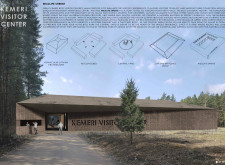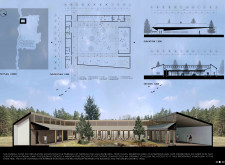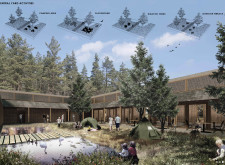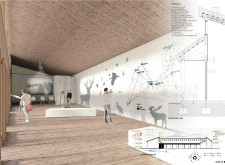5 key facts about this project
The design functions as a central hub for visitors, offering a space to learn about the unique biodiversity of the region while encouraging responsible engagement with nature. The architectural layout is organized into four distinct programmatic blocks connected by a timber gallery and features a central yard designed for community activities and gatherings.
Innovative Material Selection and Integration with Nature
The project utilizes regional materials, prominently featuring timber, thatch, concrete, and glass. Timber serves not only as a structural component but also connects the building to the traditional architecture of Latvia. The thatched roof provides insulation and an organic aesthetic that blends harmoniously with the surrounding environment. The concrete foundation ensures stability, particularly within the bog's shifting soils, while glass is strategically used to foster visual engagement with the landscape without compromising security.
A unique aspect of the Kemeri Visitor Center is its emphasis on passive solar heating principles, which are embedded within the design to minimize energy consumption. The facility’s layout promotes outdoor interaction through adaptable community spaces, including a camping area and a playground, encouraging visitors to immerse themselves in the natural habitat.
Functional and Educational Design Approaches
The interior space is consciously designed to segregate different functions while maintaining an overall coherence. The main entrance features a ticketing area that directs visitors seamlessly into the exhibition spaces, where they can explore informative displays about the bog’s wildlife and vegetation. The café and adjoining playground cater to families, providing areas for relaxation and child engagement.
The building’s architectural flow creates a natural transition through various experiential areas, enhancing the educational potential. The central yard serves as a versatile space for events and community gatherings, reinforcing the center’s role as a communal asset within Kemeri National Park.
The Kemeri Visitor Center stands out in its role as an architectural manifestation of environmental education and community engagement. Its thoughtful integration of local contexts, sustainable practices, and functional design sets it apart from similar projects. To gain a deeper understanding of this architectural endeavor, explore the project presentation and review elements such as architectural plans, architectural sections, and architectural designs that illustrate the wealth of ideas behind this project.


























